Citroen C1 2012 1.G Workshop Manual
Manufacturer: CITROEN, Model Year: 2012, Model line: C1, Model: Citroen C1 2012 1.GPages: 140, PDF Size: 4.24 MB
Page 51 of 140
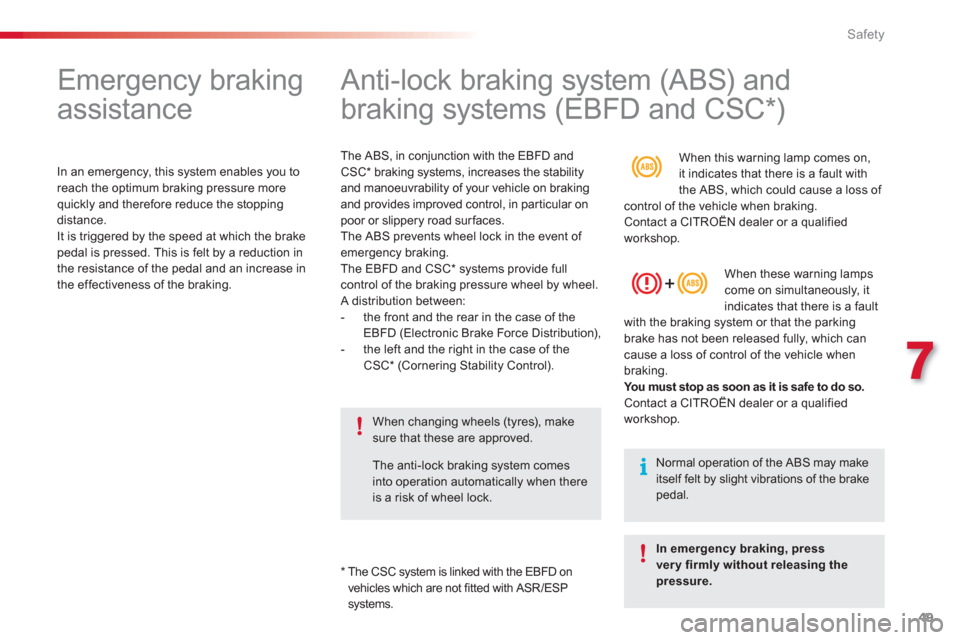
7
49 Safety
Emergency braking
assistance
In an emergency, this system enables you to
reach the optimum braking pressure morequickly and therefore reduce the stoppingdistance.
It is triggered by the speed at which the brake pedal is pressed. This is felt by a reduction in
the resistance of the pedal and an increase in
the effectiveness of the braking.
*
The CSC system is linked with the EBFD on
vehicles which are not fitted with ASR/ESP
systems.
Anti-lock braking system (ABS) and
braking systems (EBFD and CSC * )
The ABS, in conjunction with the EBFD and
CSC *
braking systems, increases the stability and manoeuvrability of your vehicle on brakingand provides improved control, in particular on poor or slippery road surfaces.
The ABS prevents wheel lock in the event of
emergency braking.
The EBFD and CSC * systems provide fullcontrol of the braking pressure wheel by wheel.A distribution between:
- the front and the rear in the case of the
EBFD (Electronic Brake Force Distribution),
- the left and the right in the case of theCSC * (Cornering Stability Control).
When changing wheels (tyres), make
sure that these are approved.
The anti-lock braking system comesinto operation automatically when thereis a risk of wheel lock.
When this warning lamp comes on,
it indicates that there is a fault with
the ABS, which could cause a loss of control of the vehicle when braking.
Contact a CITROËN dealer or a qualified
workshop.
When these warning lampscome on simultaneously, it
indicates that there is a fault
with the braking system or that the parking
brake has not been released fully, which cancause a loss of control of the vehicle when
braking. You must stop as soon as it is safe to do so. Contact a CITROËN dealer or a qualified
workshop.
Normal operation of the ABS may make itself felt by slight vibrations of the brake pedal.
In emergency braking, pressvery firmly without releasing thepressure.
Page 52 of 140
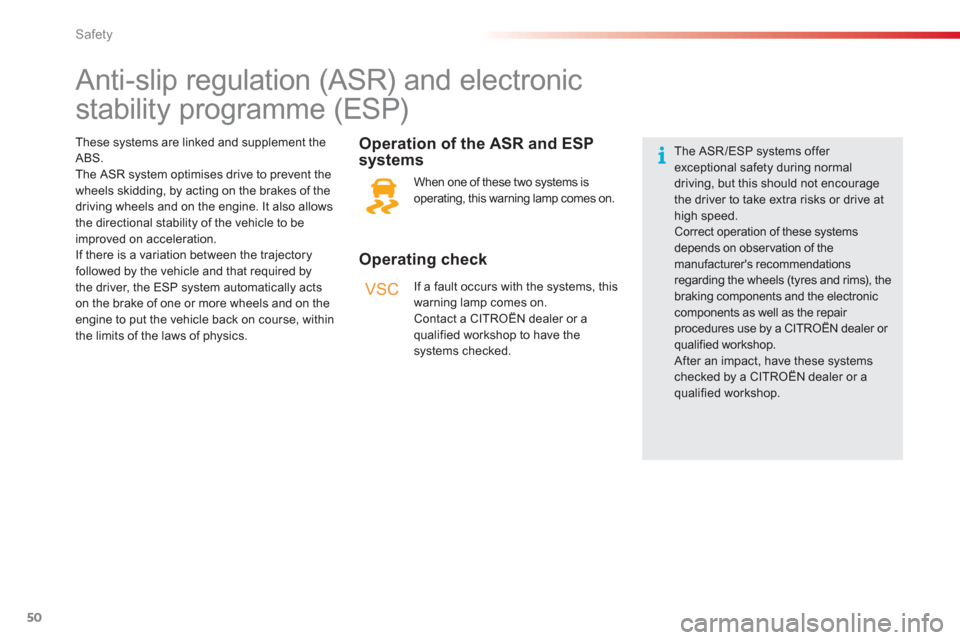
VSC
50Safety
Anti-slip regulation (ASR) and electronic
stability programme (ESP)
Operating check
Operation of the ASR and ESP
s
ystems
When one of these two systems is
operating, this warning lamp comes on.
If a fault occurs with the s
ystems, this
warning lamp comes on.
Contact a CITROËN dealer or aqualified workshop to have thesystems checked.
These systems are linked and supplement the
ABS.
The ASR system optimises drive to prevent the
wheels skidding, by acting on the brakes of the
driving wheels and on the engine. It also allows
the directional stability of the vehicle to be
improved on acceleration.
If there is a variation between the trajectory followed by the vehicle and that required by
the driver, the ESP system automatically acts on the brake of one or more wheels and on theengine to put the vehicle back on course, within
the limits of the laws of physics.
The ASR/ESP systems offer exceptional safety during normal driving, but this should not encourage the driver to take extra risks or drive athigh speed. Correct operation of these systemsdepends on obser vation of the manufacturer's recommendationsregarding the wheels (tyres and rims), thebraking components and the electronic components as well as the repair procedures use by a CITROËN dealer or qualified workshop.
After an impact, have these systemschecked by a CITROËN dealer or aqualified workshop.
Page 53 of 140
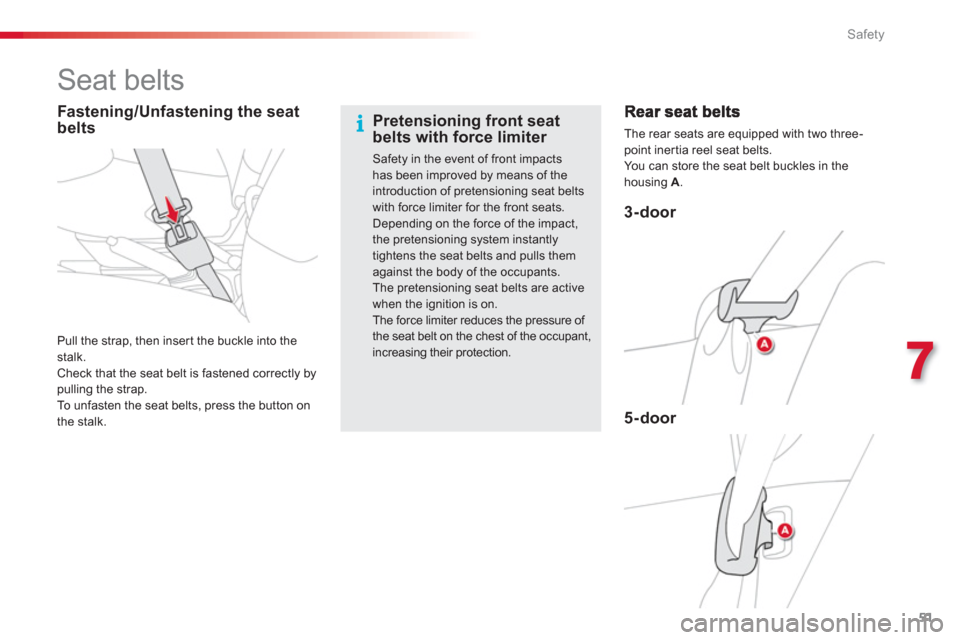
7
51 Safety
Seat belts
3-door
5-door
The rear seats are equipped with two three-point inertia reel seat belts.
Yo u can store the seat belt buckles in the housing A.
Pull the strap, then inser t the buckle into thestalk.
Check that the seat belt is fastened correctly bypulling the strap.
To unfasten the seat belts, press the button on
th
e stalk.
Pretensioning front seat belts with force limiter
Safety in the event of front impactshas been improved by means of theintroduction of pretensioning seat beltswith force limiter for the front seats.Depending on the force of the impact, the pretensioning system instantly tightens the seat belts and pulls them against the body of the occupants.
The pretensioning seat belts are activewhen the ignition is on.
The force limiter reduces the pressure of the seat belt on the chest of the occupant, increasing their protection.
Fastening/Unfastening the seatbelts
Page 54 of 140
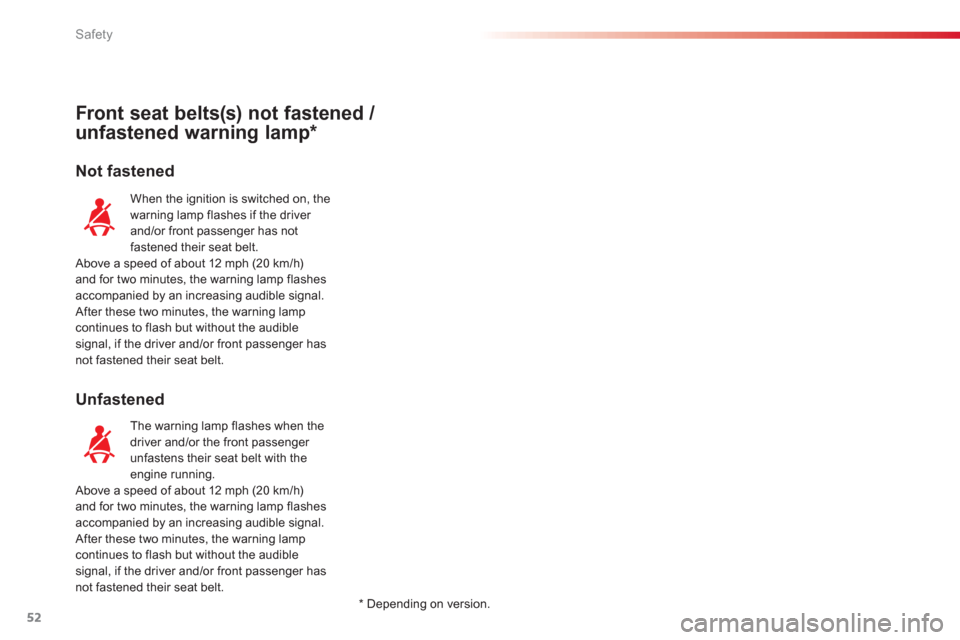
52Safety
Front seat belts(s) not fastened /
unfastened warning lamp *
Not fastened
Unfastened
When the ignition is switched on, the
warning lamp flashes if the driver
and
/or front passenger has not fastened their seat belt.
Above a speed of about 12 mph (20 km/h) and for two minutes, the warning lamp flashes accompanied by an increasing audible signal.
After these two minutes, the warning lampcontinues to flash but without the audiblesignal, if the driver and/or front passenger hasnot fastened their seat belt.
The warnin
g lamp flashes when the
driver and/or the front passenger unfastens their seat belt with the engine running.
Above a speed of about 12 mph (20 km/h) and for two minutes, the warning lamp flashes accompanied by an increasing audible signal.
After these two minutes, the warning lampcontinues to flash but without the audiblesignal, if the driver and/or front passenger has
not fastened their seat belt.
*
Dependin
g on version.
Page 55 of 140
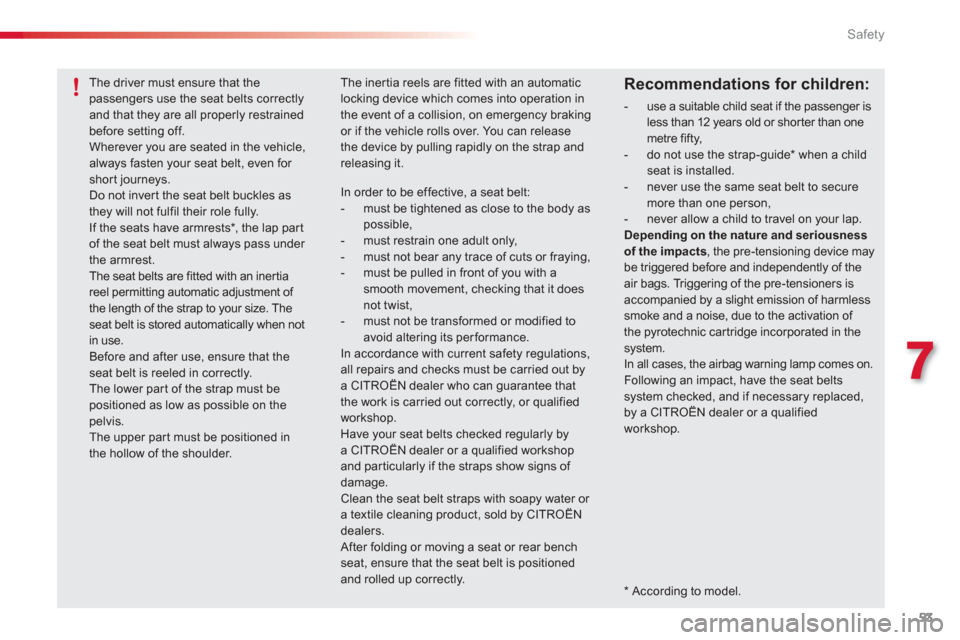
7
53 Safety
*
According to model.
The driver must ensure that thepassengers use the seat belts correctly and that they are all properly restrainedbefore setting off. Wherever you are seated in the vehicle,always fasten your seat belt, even for shor t journeys. Do not invert the seat belt buckles as they will not fulfil their role fully. If the seats have armrests * , the lap par tof the seat belt must always pass under the armrest.The seat belts are fitted with an inertia reel permitting automatic adjustment of the length of the strap to your size. The seat belt is stored automatically when notin use.Before and after use, ensure that theseat belt is reeled in correctly.The lower part of the strap must be positioned as low as possible on the pelvis. The upper par t must be positioned in the hollow of the shoulder.
The inertia reels are fitted with an automaticlocking device which comes into operation in the event of a collision, on emergency braking or if the vehicle rolls over. You can release the device by pulling rapidly on the strap and releasing it.
In order to be effective, a seat belt: - must be tightened as close to the body as
possible, - must restrain one adult only, - must not bear any trace of cuts or fraying,- must be pulled in front of you with asmooth movement, checking that it doesnot twist, - must not be transformed or modified to avoid altering its performance.In accordance with current safety regulations, all repairs and checks must be carried out bya CITROËN dealer who can guarantee thatthe work is carried out correctly, or qualifiedworkshop. Have your seat belts checked regularly by a CITROËN dealer or a qualified workshop and particularly if the straps show signs of damage.Clean the seat belt straps with soapy water or a textile cleaning product, sold by CITROËN dealers.
After folding or moving a seat or rear bench seat, ensure that the seat belt is positioned and rolled up correctly.
Recommendations for children:
- use a suitable child seat if the passenger isless than 12 years old or shor ter than one metre fifty,
- do not use the strap-guide *
when a child seat is installed.
- never use the same seat belt to securemore than one person,
- never allow a child to travel on your lap.Depending on the nature and seriousnessof the impacts, the pre-tensioning device may be triggered before and independently of theair bags. Triggering of the pre-tensioners is accompanied by a slight emission of harmless smoke and a noise, due to the activation of the pyrotechnic cartridge incorporated in the system.
In all cases, the airbag warning lamp comes on.
Following an impact, have the seat beltssystem checked, and if necessary replaced, by a CITROËN dealer or a qualifiedworkshop.
Page 56 of 140
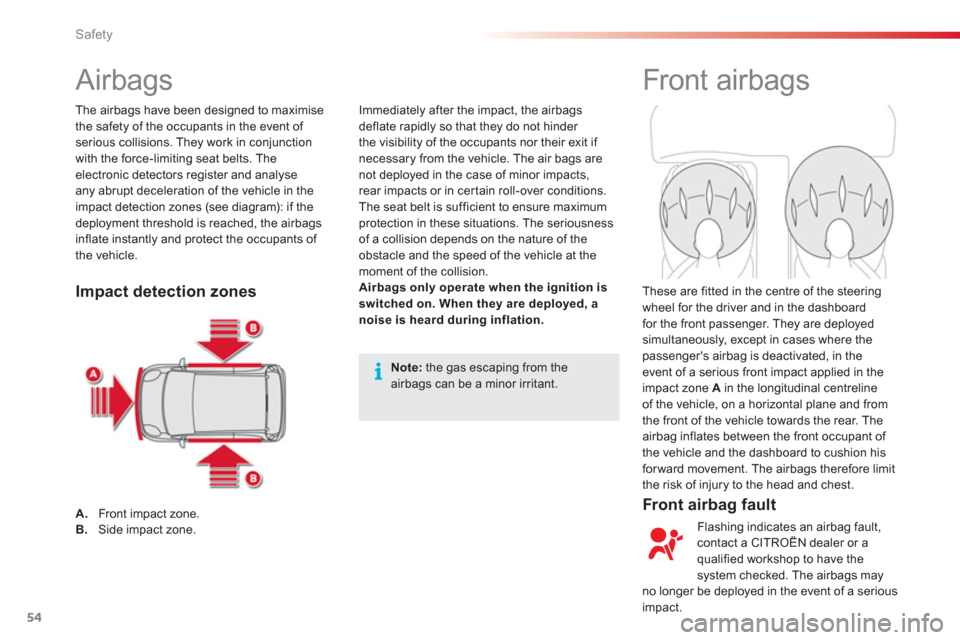
54Safety
Airbags Front airbags
Front airbag fault
Immediately after the impact, the airbags
deflate rapidly so that they do not hinder
the visibility of the occupants nor their exit if
necessary from the vehicle. The air bags are
not deployed in the case of minor impacts, rear impacts or in cer tain roll-over conditions. The seat belt is sufficient to ensure maximumprotection in these situations. The seriousness
of a collision depends on the nature of the
obstacle and the speed of the vehicle at the
m
oment of the collision.
Airbags only operate when the ignition is switched on. When they are deployed, a
noise is heard during inflation.
The airbags have been designed to maximise
the safety of the occupants in the event of serious collisions. They work in conjunction
with the force-limiting seat belts. Theelectronic detectors register and analyse any abrupt deceleration of the vehicle in the
impact detection zones (see diagram): if the
deployment threshold is reached, the airbags
in
flate instantly and protect the occupants of
the vehicle.
These are
fitted in the centre of the steeringwheel for the driver and in the dashboard for the front passenger. They are deployed simultaneously, except in cases where thepassenger's airbag is deactivated, in theevent of a serious front impact applied in the
impact zone A
in the longitudinal centreline
of the vehicle, on a horizontal plane and from
th
e front of the vehicle towards the rear. T he
airba
g inflates between the front occupant of
the vehicle and the dashboard to cushion hisfor ward movement. The airbags therefore limit
the risk of injury to the head and chest.
A.Front impact zone.B. Side impact zone.
Note:
the gas escaping from the airbags can be a minor irritant.
Flashin
g indicates an airbag fault, contact a CITROËN dealer or aqualified workshop to have the
system checked. The airbags may
no longer be deployed in the event of a serious
impact.
Impact detection zones
Page 57 of 140
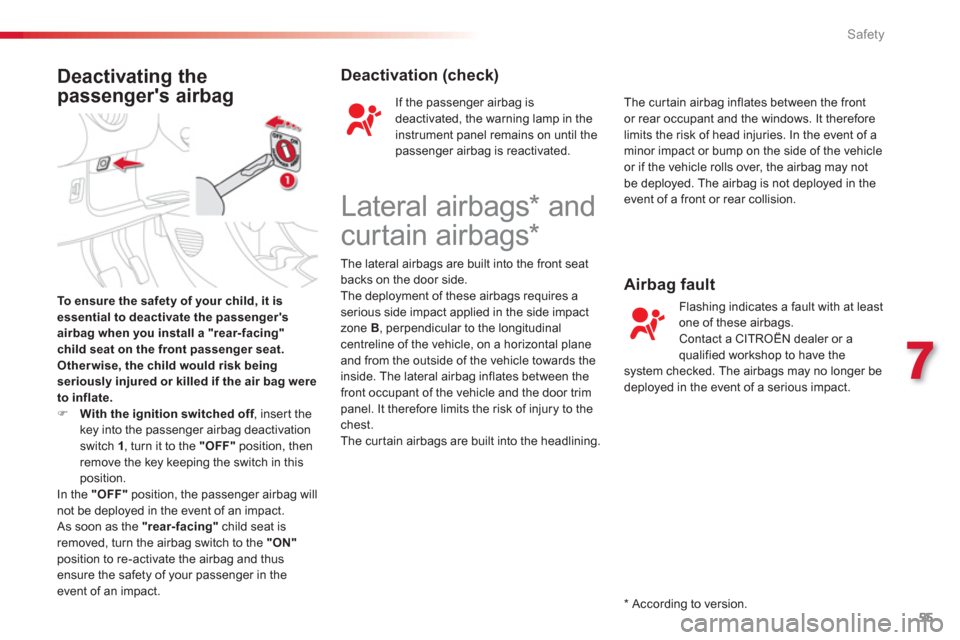
7
55 Safety
To ensure the safety of your child, it is essential to deactivate the passenger'sairbag when you install a "rear-facing"child seat on the front passenger seat.
Other wise, the child would risk being
seriously injured or killed if the air bag wereto inflate.�)With the ignition switched off, inser t thefkey into the passenger airbag deactivation switch 1, turn it to the "OFF"position, then remove the key keeping the switch in this position.
In the "OFF"position, the passenger airbag willnot be deployed in the event of an impact.
As soon as the "rear-facing"
child seat is
removed, turn the airbag switch to the "ON"position to re-activate the airbag and thus ensure the safety of your passenger in the
event of an impact. If the passen
ger airbag is
deactivated, the warning lamp in the
instrument panel remains on until the
passen
ger airbag is reactivated.
Flashin
g indicates a fault with at least
one of these airbags.Contact a CITROËN dealer or aqualified workshop to have thesystem checked. The airbags may no longer be
deployed in the event of a serious impact.
Deactivation (check)
Airba
g fault
*
According to version.
Lateral airbags * and
curtain airbags *
The lateral airbags are built into the front seatbacks on the door side.
The deployment of these airbags requires a
serious side impact applied in the side impact
zone B , perpendicular to the longitudinalcentreline of the vehicle, on a horizontal plane and from the outside of the vehicle towards the inside. The lateral airbag inflates between the front occupant of the vehicle and the door trimpanel. It therefore limits the risk of injury to the chest.
The cur tain airba
gs are built into the headlining.
The cur tain airba
g inflates between the front or rear occupant and the windows. It therefore
limits the risk of head injuries. In the event of a
minor impact or bump on the side of the vehicle
or if the vehicle rolls over, the airbag may notbe deployed. The airbag is not deployed in the event of a front or rear collision.
Deactivating the
passenger's airbag
Page 58 of 140
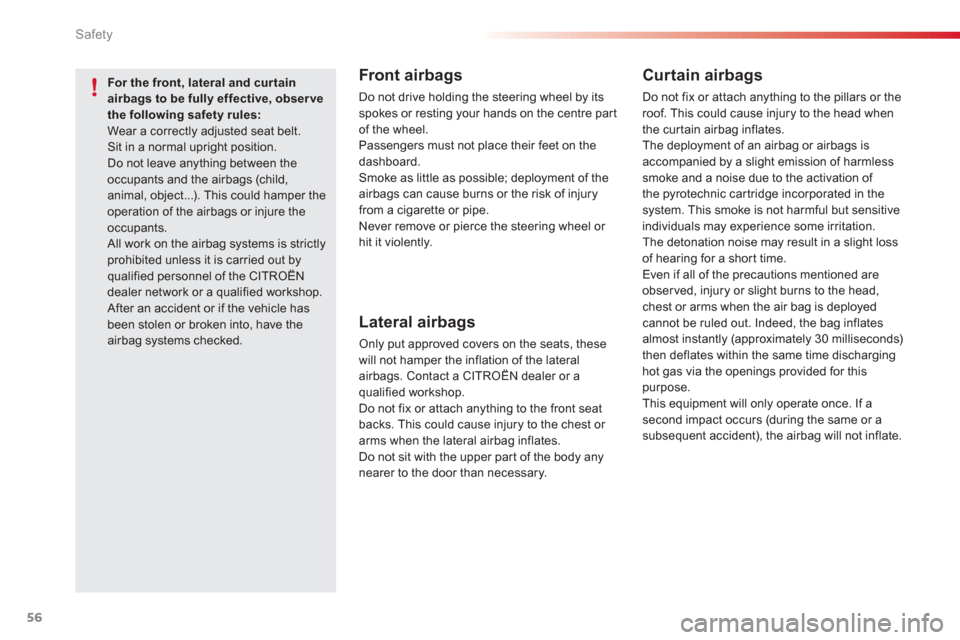
56Safety
Front airbags
Do not drive holding the steering wheel by its
spokes or resting your hands on the centre part
of the wheel.
Passengers must not place their feet on the
dashboard.
Smoke as little as possible; deployment of the
airbags can cause burns or the risk of injuryfrom a cigarette or pipe.
Never remove or pierce the steering wheel or hit it violently.
Curtain airbags
Do not fix or attach anything to the pillars or the
roof. This could cause injury to the head when
the cur tain airbag inflates.
The deployment of an airbag or airbags is
accompanied b
y a slight emission of harmlesssmoke and a noise due to the activation of
the pyrotechnic cartridge incorporated in the system. This smoke is not harmful but sensitiveindividuals may experience some irritation.
The detonation noise may result in a slight loss
of hearing for a shor t time.
Even if all of the precautions mentioned are
observed, injury or slight burns to the head,chest or arms when the air bag is deployed cannot be ruled out. Indeed, the bag inflates
almost instantly (approximately 30 milliseconds)
then deflates within the same time discharginghot gas via the openings provided for thispurpose.
This equipment will only operate once. If a second impact occurs (during the same or asubsequent accident), the airbag will not inflate.
Lateral airbags
Only put approved covers on the seats, these
will not hamper the inflation of the lateral
airbags. Contact a CITROËN dealer or a qualified workshop.
Do not fix or attach anything to the front seatbacks. This could cause injury to the chest or
arms when the lateral airba
g inflates.
Do not sit with the upper par t of the body any
nearer to the door than necessary.
For the front, lateral and cur tain airbags to be fully effective, obser ve the following safety rules:Wear a correctly adjusted seat belt. Sit in a normal upright position. Do not leave anything between the occupants and the airbags (child, animal, object...). This could hamper the operation of the airbags or injure the occupants. All work on the airbag systems is strictly prohibited unless it is carried out by qualified personnel of the CITROËN dealer network or a qualified workshop.
After an accident or if the vehicle has been stolen or broken into, have theairbag systems checked.
Page 59 of 140
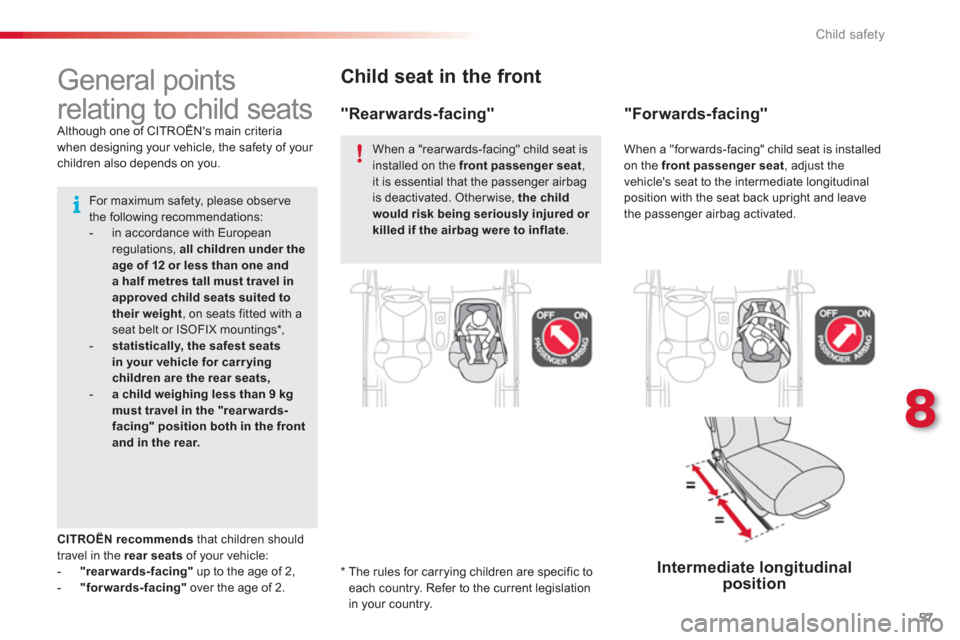
8
57 Child safety
Child seat in the front
*
The rules for carrying children are specific toeach country. Refer to the current legislation
in your country.
General points
relating to child seats
Although one of CITROËN's main criteria g
when designing your vehicle, the safety of your children also depends on you.
"Rearwards-facing"
CITROËN recommendsthat children shouldtravel in the rear seats
of your vehicle:
- "rearwards-facing"up to the age of 2,
-
"forwards-facing"
over the age of 2.
"Forwards-facing"
Intermediate longitudinalposition
For maximum safety, please observethe following recommendations: - in accordance with European regulations, all children under theage of 12 or less than one and a half metres tall must travel in approved child seats suited totheir weight
, on seats fitted with a seat belt or ISOFIX mountings *
, -statistically, the safest seats in your vehicle for carr yingchildren are the rear seats,- a child weighing less than 9 kgmust travel in the "rear wards-facing" position both in the frontand in the rear.
When a "rear wards-facing" child seat isinstalled on the front passenger seat
, it is essential that the passenger airbagis deactivated. Other wise, the child would risk being seriously injured or killed if the airbag were to inflate.
When a "forwards-facing" child seat is installed on the front passenger seat
, adjust the
vehicle's seat to the intermediate longitudinal
position with the seat back upri
ght and leave
the passenger airbag activated.
Page 60 of 140

58Child safety
Passenger airbag OFF
Refer to the advice given on the label present
on both sides of the passenger's sun visor.
To assure the safety of your child, youmust deactivate the passenger's frontairbag when you install a child seat inthe rear wards facing position on the
front passenger's seat. Other wise, there is a risk that the childcould be seriously injured or killed if theairbag were deployed.